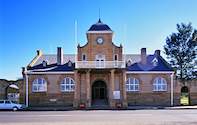In spite of its small size, Utrecht in KwaZulu-Natal, South Africa is a historical gem with ten National Monuments and 10 historical sites. The town is steeped in history, which is reflected in beautiful historical buildings like the Old Manse Museum, the Dutch Reformed sandstone church, the unique old military cemetery and stately colonial houses.

Utrecht Town Hall
The Utrecht Town Hall was erected in 1913 and is a national monument.
Utrecht Dutch Reformed Church
A national monument built in sandstone with Oregon eaves and pews. It was erected during the ministry of Rev. Neethling, the first moderator of the ‘Nederduitsche Hervormde of Gerereformeerde Kerk’ of the ‘Zuid Afrikaansche Republiek’. The foundation stone was laid by General Piet Joubert, Commandant General of the ZAR on the 21st of April 1893. The Burger monument of the Second Anglo-Boer War stands on the church square of the church.
Landdrost, Pos en Telegraafkantoor
Erected in 1892 in Utrecht, it is a national monument. Besides the period rooms, the museum portrays the border dispute between the Transvaal and Zululand.
Old Residency Parsonage
The parsonage was built for Rev. and Mrs HL Neethling, and was brought into use on the 12th of October 1888. It is now a national monument, and houses Utrecht's museum.
Old Cemetery
The last resting place of well-known Voortrekkers and British Soldiers, including Stephen Thornton Phillimore. Phillimore was the deputy Commissioner of the British army during the Anglo Zulu War. A section of the Old Cemetery is laid out in the form of an arrow pointing in a north-easterly direction. The arrow was the emblem of the British rifle in those years. Why the arrow points in a northeasterly direction is not known.
Petrus Lafras Uys Monument
Commemorating Captain Leo Pokrowski, a well known hero of the Zulu wars. He was one of the most famous foreigners to fight with the Boer forces – a Pole and an officer in the Russian army. He was killed in action on Christmas day in 1900 while he and his men were attacking the British in Utrecht.
Utrecht Anglican Church
The Anglican Church in Utrecht was erected in 1899. The interior of this small church is an architectural gem, and the building is built out of sandstone.
Old Republican Powder House
Erected in 1893, it is one of three similar structures built by the Transvaal Republic.-
The Uys House
The Uys Huis is one of the oldest buildings in Kwa-Zulu Natal north of the Tugela and dates back to 1856. It was the home of Swart Dirk Uys, who was the first Commandant of Utrecht. It was here that the Prince Imperial, Louis Napoleon, visited the lovely Sannie, daughter of Petrus Lafras Uys.
The Rothman and Shaw Houses
These are both national monuments and are considered among the finest examples of Natal colonial architecture in rural Kwa-Zulu Natal.